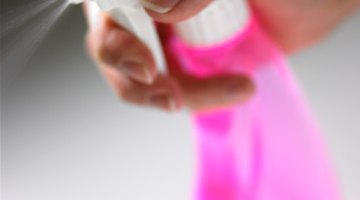How Does a Spray Bottle Work?
Many people use spray bottles every day for everything from cleaning to personal grooming, but not many know how they work. A spray bottle is designed to pull liquid from the bottle using a one-way valve.

The pump, powered by a trigger, forces the liquid through a nozzle that breaks up the flow of the liquid, turning it into a fine mist or stream.
Bottle
The bottle is the reservoir from which the pump pulls liquid when the user presses the trigger on the spray bottle. The liquid moves from the bottle up the tube. The tube and reservoir are similar in spray bottles and other kinds of pumps, such as pumps on soap dispensers. For thin liquids such as cleaning products, a thinner tube can work, but for thicker liquids such as hand soap, a thicker tube is necessary to pull liquid.
Pump
The pump is the main working part of a spray bottle. The pump consists of the trigger mechanism, a piston, a cylinder and a one-way valve. When the user presses the trigger, it forces the piston into the cylinder, which forces the liquid through the nozzle as a concentrated stream of liquid. When the trigger is released, the piston moves back, pulling liquid back into the cylinder. This liquid is forced out of the nozzle the next time the trigger is pressed. A one-way valve at the bottom of the pump only allows liquid to flow up the tube into the pump, not back into the bottle.
Nozzle
The nozzle of the spray bottle concentrates the liquid into a stream by forcing it through a very small hole. Spray bottle nozzles also have a one-way valve in them that keeps air from flowing back into the pump and allows for suction within the pump so that liquid can be pulled up the tube. Without this valve, the pump would suck air back into the cylinder, instead of liquid up from the bottle.
Other Design Elements
Some nozzles have a built in screen with lots of tiny holes that make the liquid emerge as a mist, and some can screw down to lock the bottle and prevent fluid from escaping. The tube on some spray bottles also has a wider part at the bottom to allow for easier uptake of the fluid. Sometimes, this wider tube end has a screen over it so that solid matter doesn't get sucked into the tube.
References
Writer Bio
As a writing tutor since 2007, Amanda Gaddis has experience in explaining complex subjects simply. She is excited to write articles on education and literature. Gaddis holds a Bachelor of Arts in English from Stephen F. Austin State University, and had her creative writing published in their literary magazine.
Photo Credits
- BananaStock/BananaStock/Getty Images
- BananaStock/BananaStock/Getty Images
More Articles



